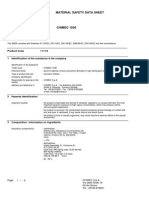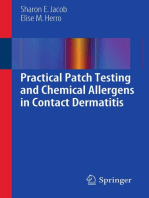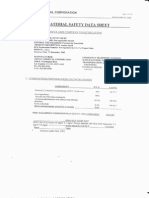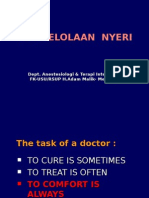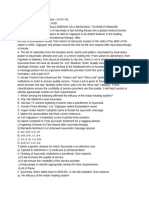Crackdown 15 EC
Crackdown 15 EC
Uploaded by
Sadhana SentosaCopyright:
Available Formats
Crackdown 15 EC
Crackdown 15 EC
Uploaded by
Sadhana SentosaCopyright
Available Formats
Share this document
Did you find this document useful?
Is this content inappropriate?
Copyright:
Available Formats
Crackdown 15 EC
Crackdown 15 EC
Uploaded by
Sadhana SentosaCopyright:
Available Formats
MATERIAL SAFETY DATA SHEET NAGR 2015 1.
IDENTIFICATION OF THE SUBSTANCE OR PREPARATION AND THE COMPANY : CRACKDOWN 15 EC : AEF03264000EC02A1 : Hoechst Schering AgrEvo S.A. Saint Aubin Les Algorithmes, Immeuble THALES GIF sur YVETTE CEDEX 91197 FRANCE Toxicology Logistic 2. Tel:(33)4.91.24.45.83 Tel:(33)4.91.24.45.45 Fax:(33)4.91.24.46.84 Fax:(33)4.91.24.46.46 Tel:(33)4.91.35.96.96 Fax:(33)4.91.24.46.46
Trade name Product code Supplier
Medical emergency phone number 24H/24H 2-1. Composition/Information on ingredients Synonyms Chemical family Kind of use CAS 052918-63-5 064742-95-6 3.
COMPOSITION/INFORMATION ON INGREDIENTS :Deltamethrin: 15g/I EC :Pyrethroids :Insecticide. Emulsifiable concentrate. EINECS 258-256-6 265-199-0 Wording Deltamethrin Petroleum Concentration 15g/I 800g/I Symbol T,N Xn,N Risks Phrases 20-25-50/53 10-37-51/53-56
2-2. Hazardous constituents
HAZARDS IDENTIFICATION EC:Not classified
Symbols and labelling
Main hazards Specifics risks Main accute symptoms
: Flammable : Dangerous to aquatic organisms. : *The following symptoms may occur: *Local: skin and eyes paraesthesiae which may be severe. Usually transient with resolution within 24 hours. *Systemic: dizziness, headache, listlessness, nausea and vomiting, epigastric pain, muscular fasciculation of limbs, unconsciousness, convulsions and coma (very high doses)
4.
FIRST-AID MESURES IN CASE OF EXPOSURE :*Symptomatic treatment after decontamination. *Local contamination: *Skin: apply vitamin E cream or simple toilet milks. *Eye: instillation of local anaesthetic drops e.g. 1% amethocaine hydrochloride eye drops.
Instructions for physicain
*Give analgesics as necessary. *Can cause severe pain. *Systemic poisoning. *Monitor fonction: respiratory, cardiac. *Observe specific parameters: electrocardiograph, check for pulmonary oedema in event inhalation. *Gastric lavage. Charcoal administration. *Endotracheal intubation. Artifcial respiration as necessary. *Elimination by: dialysis, haemo-perfusion. *Anticonvulsions therapy: diazepam i.v. *Contraindications: 1.Adrenergic compounds. 2 Areopine. *Recovery: spontaneous. *Must not be confused with organophosphorous compounds. Inhalation :Remove to fresh air. *Keep at rest. If required, seek medical advice immediately. Skin contact :*Carefully remove contaminated clothing. *Wash affected area with soap and water. In case of persistent irritation, seek medical advice. Eyes Contact Ingestion :*Rinse immediately with clean water for at least 15 minutes and obtain Medical aid. :*Wash out mouth with water. *Do not induce vomiting. *Give water to drink. *Keep patient at rest. *Obtain medical advice immediately. 5. FIRE-FIGHTING MEASURES : Water spray jet, CO2, foam, dry chemical. : Jet of water from a fire hose. : In case of hire, the product emits toxic and irritating fumes. : Wear suitable protective clothing. Wear a self-contained breathing apparatus. Other recommendations : Avoid rejection of extinguishing water in the environment. Cool with water the containers against excessive heat. Keep away fromm heat and flame if possible. Do not breathe fumes. Suitable extinguishing media Unsuitable extinguishing Media Fire and explosion hazards Special protective equipment
6.
ACCIDENTAL RELEASE MEASURES : *Before intervention wear protective equipment (cf 8-2). Avoid contact with chemical or contaminated surfaces.
Personal protection
Environment precautions
: Absorb with liquid binding material (sand, cement, line). Sweep and store the material collected into a suitable container. Keep safe for disposal according to regulations. Prevent entry into drains, sewers and watercourses.
Clean-up procedures
: Rinse the contaminated area with a large quantity of water and cleaning agent.
7.
HANDLING AND STORAGE : Use local exhaust ventilation at the source of the contamination. Emergency shower and eye-wash system should be available.
7-1. HANDLING Technical measures
Special protection measures : Do not spray facing the wind. Special precautions 7-2. STORAGE Sensitivity to damp Sensitivity to light Sensitivity to oxidation Storage temperature Low temperature to be avoided Special storage requirement : Keep away from food, drink and animal feeding stuffs. Storage facilities Recommended packaging material Supplier packaging Packaging material to be avoided Other recommendations : Keep only in the original container. Do not re-use empty containers. Respect the height of advice piling. 8. EXPOSURE CONTROLS/PERSONNAL PROTECTION : Wear mask with organic vapour cartridge (A) : Wear solvent-proof gloves. : P.E.T., Steel drum. : PEHD. : *Store in a well ventilated place. : *Aluminium, tinplate, PET, iron. : Not observed. : *Keep protected from direct sunlight. : Not observed. : Keep at ambient temperature. : *Protect from frost (Crystal formation reversible). : Wash hands and exposed part of the body with soap after any handling.
8-1. CONTROL OF EXPOSURE Respiratory protection Hands protection
Eyes protection Skin and body protection Specific hygiene measures 9. PH Characteristic temperatures Flash point Auto-Inflammability Inflammability limits
: *Wear goggles. : Wear suitable protective clothing. : Use only in well-ventilated area.
PHYSICAL AND CHEMICAL PROPERTIES : Light yellow liquid, aromatic odor. : 5 to 7 at 1% in water. : Freezing point: less than-10. : 42 (Closed cup). : 450 (solvent). : Lower: 0.8% m/m (solvent). Upper: 7% m/m (solvent).
Appearance
Inflammability Density Solubility Partition coefficient Octanol/Water
: Flammable. : 0.88 to 0.90 at 20 : Emulsifiable in water : *Deltamethrin: Log Pow =5.43
10. STABILITY AND REACTIVITY Products of decomposition Avoided conditions :*No decomposition under normal conditions. :*Keep away from heat and source of ignition.
11. TOXICOLOGICAL INFORMATION Acute toxicity :Toxicological assesment made on a similar composition (25 g/l). LD 50 oral route/rat: (male+female): 431 mg/kg. LD 50 cutaneous route/rabbit:>2000mg/kg. Irritant potential : Toxicological assesment made on a similar composition (25 g/l). Ocular irritation (rabbit): very irritating. Cutaneous irritation (rabbit): slightly irritation/ Sensitization : Toxicological assesment made on a similar composition (25g/l). Not sensitizing (guinea-pig) : (Buehler). Due to the presence of solvents in the preparation dermatosis may occur by repeated and prolonged contact with skin. Chronic toxicity : *Deltamethrin. Not mutagenic. Not teratogenic Not carcinogenic.
*Deltamethrin : NOEL = 1 mg/kg.bw/day. Comments/symptoms : Somer cutaneous sensations may occur, such as burning, stinging Sensations on the face and mucosa, without lesions and transient some hours, maximum 24 h. *Due to the presence of solvens in the preparation, may cause lung damage if swallowed. 12. ECOLOGICAL INFORMATION Environment protection Mobility Ecotoxicity :Prevent entry into drains, sewers and watercourses :Deltamethrin: fixed in most soils. :*Deltamethrin: LC50 (96h) fish: 0.001-0.01 mg/l. EC 50 (48) daphnia: 0.0035 mg/l. IC 50 (72) algae:>1000 mg/l. 13. DISPOSAL CONSIDERATIONS Waste and residue :Incineration in accordance with the local waste regulation authority. *Do not discharge washing waters in public sewers and water sources (ponds, streams) Destruction soiled packaging :Empty and tripe rinse. Make the container unsuable. Disposal must be traited according to official regulation. 14. TRANSPORT INFORMATION NUN 14-1.BY ROAD Transport assimilation Class Item number Label Hazards Code 14-2. O.A.C.I. (By Air) Transport assimilation Class Group Label Passengers Cargo :Flammable liquid, n.o.s. (Petroleum distillates) :3 :III :3 :309 (60L) :310 (220L) :Flammable liquid, n.o.s. (Petroleum distillates) :3 :31) :3 :30 :1993 Persistence and degradability :Deltamethrin: DT 50 in most soils from 4 to 9 days.
14-3. I.M.D.G. (By Sea) Transport assimilation Class Group Label Mark :Flammable liquid, n.o.s. (Petroleum distillates) :3.3 :III, page 3345 :3 :Marine pollutant (Deltamethrin)
15. REGULATORY INFORMATION 15-2. LOCAL REGULATIONS OF COUNTRY Listed facilities Professional diseases Biomonitoring Symbols and labelling EC: Not classified SPECIAL RISKS (R) 10 SAFETY ADVICE (S) 2 13 20/21 36/37/39 45 :Keep out of the reach of children. :Keep away from food, drink and animal feedingstuffs. :When using do not eat, drink or smoke. :Wear suitable protective clothing, gloves and eyes/face protection. :In case of accident or if you feel unwell, seek medical advice immediately (show the label where possible). 16. OTHER INFORMATION Further indications :Refer also to technical instructions for use. MSDS: AGR 1182 The inforamtion given in this data sheet has been introduced in accordance with the guidelines established by article 10 of EEC directive, dated March 5,1991. This data sheet complements the userss instructions, but does not replace them. The information it contains is based on the knowledge available about the product conerned at the time it was compiled. Users are further reminded of the possible a product for purposes other then those for which it was intended. The required information complies with current EEC legislation. Addressees are requested to apply any additional national requirements. Document on reference :In-house data. :Flammable. :1155-253B (France). :Concerned, board 4bis and 84 (France). :Blood test (France).
You might also like
- Draugadrotinn Lord of The Undead by N.D. BlackwoodDocument157 pagesDraugadrotinn Lord of The Undead by N.D. Blackwoodtromppainen03100% (2)
- Manual Service CavitadorDocument29 pagesManual Service CavitadorErik Sanchez HernandezNo ratings yet
- Hempadur 4714911150 En-UsDocument11 pagesHempadur 4714911150 En-Uskhalid764No ratings yet
- Improper Food HandlingDocument2 pagesImproper Food HandlingampalNo ratings yet
- Animal Testing Persuasive EssayDocument5 pagesAnimal Testing Persuasive Essayapi-2538868140% (1)
- Methanol BP. PH - Eur MSDSDocument9 pagesMethanol BP. PH - Eur MSDSshuvo.shahaNo ratings yet
- Actellic 50 EcDocument9 pagesActellic 50 Ecnadi1onlyNo ratings yet
- Mono Ethylene Glycol (ICC English)Document5 pagesMono Ethylene Glycol (ICC English)Onur SapmazNo ratings yet
- Safety Data Sheet: Tokyo Chemical Industry Co., LTDDocument5 pagesSafety Data Sheet: Tokyo Chemical Industry Co., LTDJonny DenNo ratings yet
- SDS Belnet Usa en - 01-12-2022Document11 pagesSDS Belnet Usa en - 01-12-2022LuizNo ratings yet
- Trichloroacetic AcidDocument10 pagesTrichloroacetic Acidwillyvh99No ratings yet
- MSDS - Dipentamethylenethiuram TetrasulphideDocument4 pagesMSDS - Dipentamethylenethiuram TetrasulphideBeh Jyh JiunnNo ratings yet
- FDS Bisulfite de Potassium 150 (En)Document5 pagesFDS Bisulfite de Potassium 150 (En)oshristi13No ratings yet
- Safety Data Sheet: Trigonox CDocument9 pagesSafety Data Sheet: Trigonox CWisely ChanNo ratings yet
- Safety Data Sheet: According To EC Directive 91/155/EECDocument6 pagesSafety Data Sheet: According To EC Directive 91/155/EECSiti HannaNo ratings yet
- 11630Document11 pages11630Sajeesh KrishnanNo ratings yet
- EthylacetateDocument5 pagesEthylacetateA.Magied MahmoudNo ratings yet
- Material Safety Data Sheet: Ethylene GlycolDocument9 pagesMaterial Safety Data Sheet: Ethylene GlycolsahilchemNo ratings yet
- Ethylene Glycol Msds 2Document9 pagesEthylene Glycol Msds 2sahilchemNo ratings yet
- SDS-8100 - Et GrayDocument6 pagesSDS-8100 - Et GrayUltrapure AnalytichemNo ratings yet
- High Тemp v2: Photoreactive Resin for Form 2Document8 pagesHigh Тemp v2: Photoreactive Resin for Form 2pnpexpertsNo ratings yet
- MSDS-RIPSTAR 156-Part 1Document6 pagesMSDS-RIPSTAR 156-Part 1Ankita Baban GavadeNo ratings yet
- SDS - Safety Data Sheet: 1. IdentificationDocument8 pagesSDS - Safety Data Sheet: 1. IdentificationAli El AliNo ratings yet
- MSDS TolueneDocument11 pagesMSDS TolueneRoy JudeNo ratings yet
- SDS Nitocote EP403 HardenerDocument4 pagesSDS Nitocote EP403 HardenerNIJESHNo ratings yet
- EPICON FINISH Grey CS-614Document11 pagesEPICON FINISH Grey CS-614sergey.shushkanov1986No ratings yet
- Uc Msds Hempel UndercoatDocument5 pagesUc Msds Hempel UndercoatdfountoukidisNo ratings yet
- MSDS Reach Potassium Silico FluorideDocument6 pagesMSDS Reach Potassium Silico Fluoridesamir5yNo ratings yet
- Sealbond ETL100 Epoxy Tank LiningmsdsDocument5 pagesSealbond ETL100 Epoxy Tank LiningmsdsRzeus AdigueNo ratings yet
- MSDS NaphthaleneDocument6 pagesMSDS NaphthaleneasnandyNo ratings yet
- HI-PON 20-03 EPOXY RED OXIDE PRIMER - SDS (Ver 4.1.1) - 24.09.2021Document9 pagesHI-PON 20-03 EPOXY RED OXIDE PRIMER - SDS (Ver 4.1.1) - 24.09.2021Sathiya SaravananNo ratings yet
- Msds BPGDocument9 pagesMsds BPGSwapnil ThakurNo ratings yet
- Oxyblock DDocument13 pagesOxyblock DВиталий ВойкуNo ratings yet
- triethylamineDocument6 pagestriethylamineNaveera BaigNo ratings yet
- MSDS 1-ChlorobutaneDocument4 pagesMSDS 1-Chlorobutanefofia1955No ratings yet
- YD128 - KUKDO EpoxyDocument3 pagesYD128 - KUKDO EpoxyBarry MilburnNo ratings yet
- Black Plastic MEK Ink Part No 302-1003-001 - TINTADocument9 pagesBlack Plastic MEK Ink Part No 302-1003-001 - TINTAAlexander MamaniNo ratings yet
- Food Grade Silicone Lube 8036 - USDocument7 pagesFood Grade Silicone Lube 8036 - USMichael Torres TorresNo ratings yet
- Safety Data Sheet: AcetoneDocument4 pagesSafety Data Sheet: AcetoneBuwanah SelvaarajNo ratings yet
- Material Safety Data Sheet-AcrobatDocument8 pagesMaterial Safety Data Sheet-AcrobatMash HudaNo ratings yet
- V 1301 Eco Ba ThinnerDocument5 pagesV 1301 Eco Ba Thinneralinus4y100% (1)
- Silicon HR Silver, BaseDocument11 pagesSilicon HR Silver, Basesergey.shushkanov1986No ratings yet
- MSD Eg 20Document5 pagesMSD Eg 20Julio MendezNo ratings yet
- MSDS - CHIMEC 1038 - Gas Corr. InhibitorDocument6 pagesMSDS - CHIMEC 1038 - Gas Corr. InhibitorAnonymous LfeGI2hM0% (1)
- Premise 200 SC Termiticide PDF 37kbDocument8 pagesPremise 200 SC Termiticide PDF 37kbMYUTILITYNo ratings yet
- Safety Data SheetDocument13 pagesSafety Data SheetArdyas Wisnu BaskoroNo ratings yet
- Bitulastic Emoseal: Safety Data SheetDocument7 pagesBitulastic Emoseal: Safety Data Sheetdarren dmuscat1hotmail.comNo ratings yet
- Safety Data Sheet: Tokyo Chemical Industry Co., LTDDocument4 pagesSafety Data Sheet: Tokyo Chemical Industry Co., LTDPrabhashi RanasingheNo ratings yet
- MSDS-RIPSTAR 122-Part 2Document6 pagesMSDS-RIPSTAR 122-Part 2Ankita Baban GavadeNo ratings yet
- Msds Safety: (MaterialDocument5 pagesMsds Safety: (MaterialDerya GökNo ratings yet
- (ch3) 2so4Document6 pages(ch3) 2so4arbol100No ratings yet
- MSDSDocument7 pagesMSDSShahid IqbalNo ratings yet
- A0200 Acetic Acid Glacial EngDocument5 pagesA0200 Acetic Acid Glacial EngWaqas RamayNo ratings yet
- MSDS - Fault-Finder Developer Group 1 1073 - USDocument7 pagesMSDS - Fault-Finder Developer Group 1 1073 - USMijalo TiburonNo ratings yet
- Safety Data Sheet: According To EC Directive 91/155/EECDocument6 pagesSafety Data Sheet: According To EC Directive 91/155/EECSiti HannaNo ratings yet
- Silva SparDocument10 pagesSilva Sparsergey.shushkanov1986No ratings yet
- Loctite 406Document7 pagesLoctite 406ramstoriesNo ratings yet
- Etyl Mercaptan MSDSDocument24 pagesEtyl Mercaptan MSDSmostafa_1000100% (1)
- Safety Data Sheet: According To EC Directive 91/155/EECDocument0 pagesSafety Data Sheet: According To EC Directive 91/155/EECWilliam ChandraNo ratings yet
- First Aid on the Farm: Natural and Conventional TreatmentsFrom EverandFirst Aid on the Farm: Natural and Conventional TreatmentsNo ratings yet
- Georgia Pest Management Handbook: 2021 Home and Garden EditionFrom EverandGeorgia Pest Management Handbook: 2021 Home and Garden EditionEmily CabreraNo ratings yet
- Practical Patch Testing and Chemical Allergens in Contact DermatitisFrom EverandPractical Patch Testing and Chemical Allergens in Contact DermatitisNo ratings yet
- After a Disaster - Information to Help You and Your Family RecoverFrom EverandAfter a Disaster - Information to Help You and Your Family RecoverNo ratings yet
- Tenopa 60SC MSDSDocument8 pagesTenopa 60SC MSDSSadhana SentosaNo ratings yet
- Perangkap Kecoa Trap A Roach Hoy Hoy MSDSDocument1 pagePerangkap Kecoa Trap A Roach Hoy Hoy MSDSSadhana SentosaNo ratings yet
- MSDS Mustang 25ECDocument10 pagesMSDS Mustang 25ECSadhana Sentosa100% (2)
- MSDS KleratDocument4 pagesMSDS KleratSadhana Sentosa100% (2)
- MSDS K-Othrine 20 EWDocument8 pagesMSDS K-Othrine 20 EWSadhana SentosaNo ratings yet
- MSDS Maxforce QuantumDocument4 pagesMSDS Maxforce QuantumSadhana SentosaNo ratings yet
- MSDS Seruni 100ECDocument3 pagesMSDS Seruni 100ECSadhana Sentosa100% (1)
- MSDS VirukillDocument7 pagesMSDS VirukillSadhana Sentosa67% (3)
- MSDS Lem Tikus Cap GajahDocument2 pagesMSDS Lem Tikus Cap GajahSadhana Sentosa100% (2)
- Ficam 80 WP MsdsDocument7 pagesFicam 80 WP MsdsSadhana SentosaNo ratings yet
- MSDS Crown 100 ECDocument3 pagesMSDS Crown 100 ECSadhana SentosaNo ratings yet
- MSDS Bistar 25 ECDocument7 pagesMSDS Bistar 25 ECSadhana SentosaNo ratings yet
- MSDS Blattanex GelDocument5 pagesMSDS Blattanex GelSadhana SentosaNo ratings yet
- MSDS Agenda 25 ECDocument3 pagesMSDS Agenda 25 ECSadhana Sentosa100% (1)
- MSDS Nuvet 200 ECDocument5 pagesMSDS Nuvet 200 ECSadhana Sentosa50% (2)
- Cerebellar Lesions: Prof Anura WeerasingheDocument6 pagesCerebellar Lesions: Prof Anura WeerasingheanojanNo ratings yet
- First Periodic Test in Science 4 (Easy Type) PowerpointDocument24 pagesFirst Periodic Test in Science 4 (Easy Type) PowerpointjhoNo ratings yet
- The Clinical and Cost-Effectiveness of Neurostimulation For Relief of Chronic Neuropathic PainDocument252 pagesThe Clinical and Cost-Effectiveness of Neurostimulation For Relief of Chronic Neuropathic PainTannov SiregarNo ratings yet
- Informes Lactancia ALBADocument226 pagesInformes Lactancia ALBAmariajose1506No ratings yet
- Bloodstream Infection Event (Central Line-Associated Bloodstream Infection and Non-Central Line Associated Bloodstream Infection)Document39 pagesBloodstream Infection Event (Central Line-Associated Bloodstream Infection and Non-Central Line Associated Bloodstream Infection)fathimzahroNo ratings yet
- Lara E-Portfolio Resume 2016Document3 pagesLara E-Portfolio Resume 2016api-314325486No ratings yet
- IV. Modul 10 - Pengelolaan NyeriDocument97 pagesIV. Modul 10 - Pengelolaan NyeriGrace Noviyanthi SinambelaNo ratings yet
- Deficiency Diseases - Class 6, Components of FoodDocument5 pagesDeficiency Diseases - Class 6, Components of FoodPriya100% (1)
- GMOs PDFDocument32 pagesGMOs PDFShalyn ArimaoNo ratings yet
- Systemic Lupus ErythematosusDocument64 pagesSystemic Lupus Erythematosusganga2424100% (1)
- Nervous System Concept MapDocument12 pagesNervous System Concept MapJo BrackenNo ratings yet
- Manual of S3102E V07-20220609Document2 pagesManual of S3102E V07-20220609BIOCHECK PCRNo ratings yet
- R.D Paper I 2020Document4 pagesR.D Paper I 2020Monika SinghalNo ratings yet
- Animal Raising-Week 8-Q1Document6 pagesAnimal Raising-Week 8-Q1Jannieryl Niedo - MataNo ratings yet
- Module 5 Product 1. Personal Hygiene Habits. Home and Environment CleaningDocument1 pageModule 5 Product 1. Personal Hygiene Habits. Home and Environment CleaningScribdTranslationsNo ratings yet
- Multiple Choice: Choose Best (2.5 Points Each, 80Document7 pagesMultiple Choice: Choose Best (2.5 Points Each, 80Florence BamigbolaNo ratings yet
- PassageDocument2 pagesPassagehiru raj100% (1)
- Aseptic Technique: Prepared by Samira Fattah Assis. Lec. College of Health sciences-HMUDocument21 pagesAseptic Technique: Prepared by Samira Fattah Assis. Lec. College of Health sciences-HMUMaria Lourdes OracionNo ratings yet
- Malnutrition, - Frailty, - and - Sarcopenia - in - Patients. p1-p25 PDFDocument34 pagesMalnutrition, - Frailty, - and - Sarcopenia - in - Patients. p1-p25 PDFRahma KhalafNo ratings yet
- Allergy - 2016 - Late Breaking Poster Session LB TPS 10 18Document42 pagesAllergy - 2016 - Late Breaking Poster Session LB TPS 10 18PATRICIANo ratings yet
- NLP - How To Play The Brain GameDocument9 pagesNLP - How To Play The Brain GameElőd Zoltán Szász100% (1)
- Radiology in ENT-1Document64 pagesRadiology in ENT-1SahilNo ratings yet
- Stress Management Stress Management: NptelDocument99 pagesStress Management Stress Management: NptelDKNo ratings yet
- Intervention HandoutDocument1 pageIntervention HandoutDawn FarmNo ratings yet
- General Surgery BlueprintDocument2 pagesGeneral Surgery BlueprintMohammed FaragNo ratings yet
- Postgraduate Notes in Orthodontics-300-340Document41 pagesPostgraduate Notes in Orthodontics-300-340Mu'taz ArmanNo ratings yet











































